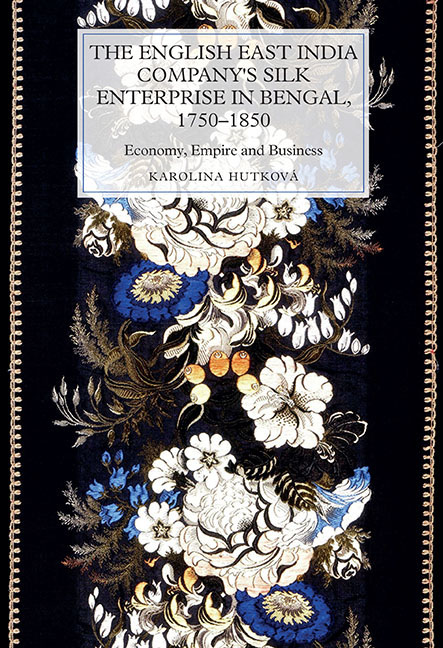Book contents
- Frontmatter
- Contents
- List of Illustrations
- Acknowledgements
- List of Abbreviations
- Measures and Currencies
- Introduction: Companies, Political Economy and the Great Divergenc
- Chapter 1 The Early Modern Silk Industry, Trade and Mercantilism
- Chapter 2 Empire, the English East India Company, and Bengal Raw Silk
- Chapter 3 Bengal, Piedmont and the English East India Company
- Chapter 4 The Bengal Silk Industry and the English East India Company
- Chapter 5 Filatures and Performance in the Bengal Silk Industry
- Chapter 6 The Bengal Silk Industry and British Laissez-Faire Policies
- Chapter 7 Bengal Raw Silk and British Demand in the Nineteenth Century
- Conclusion
- Appendix A Description of the Piedmontese Reeling Machine by Dionysius Lardner
- Appendix B Average Prices of Bengal Raw Silk on the British Market According to the Type of the Silk, 1796–1856
- Appendix C Return on Investment Analysis
- Appendix D Comparison of Manufacturing Costs at the EEIC's Experimental Filature and Common Filature in its Vicinity, 1832
- Appendix E Mechanisation of Silk Throwing and Weaving in England and Scotland, 1856
- Appendix F Types of Silkworm Reared in Bengal Silk Districts, 1818
- Appendix G Glossary
- Bibliography
- Index
- WORLDS OF THE EAST INDIA COMPANY
- Frontmatter
- Contents
- List of Illustrations
- Acknowledgements
- List of Abbreviations
- Measures and Currencies
- Introduction: Companies, Political Economy and the Great Divergenc
- Chapter 1 The Early Modern Silk Industry, Trade and Mercantilism
- Chapter 2 Empire, the English East India Company, and Bengal Raw Silk
- Chapter 3 Bengal, Piedmont and the English East India Company
- Chapter 4 The Bengal Silk Industry and the English East India Company
- Chapter 5 Filatures and Performance in the Bengal Silk Industry
- Chapter 6 The Bengal Silk Industry and British Laissez-Faire Policies
- Chapter 7 Bengal Raw Silk and British Demand in the Nineteenth Century
- Conclusion
- Appendix A Description of the Piedmontese Reeling Machine by Dionysius Lardner
- Appendix B Average Prices of Bengal Raw Silk on the British Market According to the Type of the Silk, 1796–1856
- Appendix C Return on Investment Analysis
- Appendix D Comparison of Manufacturing Costs at the EEIC's Experimental Filature and Common Filature in its Vicinity, 1832
- Appendix E Mechanisation of Silk Throwing and Weaving in England and Scotland, 1856
- Appendix F Types of Silkworm Reared in Bengal Silk Districts, 1818
- Appendix G Glossary
- Bibliography
- Index
- WORLDS OF THE EAST INDIA COMPANY
Summary
The early modern silk industry has received considerably less attention than other industries, such as cotton, linen and woollens, or ceramics and metalwares, which has in turn downplayed its importance in early modern economies. Yet, the silk industry pioneered new technologies and new systems of organisation of production that only took root in other sectors centuries later. Complex silk-reeling machines, for instance, were already in use for the production of silk threads in the early seventeenth century. In contrast, the celebrated machinery for spinning cotton was only invented in Europe in the late eighteenth century. Today, it is believed that cotton-spinning technologies heavily borrowed from mechanised silk reeling. Likewise, a centralised system of production was first adopted in textile manufacturing for the reeling of silk. Such early-seventeenth-century technological adoption was driven by demand rather than supply-side conditions: it was the demand for highand standard-quality silk threads and yarns that led to major technological innovations. In the nineteenth century, the raw silk trade was one of the first to experience high levels of market integration. This was a further impetus for standardisation of quality, employing mechanisation and modernising the system of labour organisation and management.
The key innovations in technologies and systems of organisation emerged in Italy such that the north-western region of Piedmont became the leader in producing high-quality silk thread and yarn in Europe. Several other silkproducing regions in other countries attempted to emulate Piedmont and, in the course of the late seventeenth and eighteenth centuries, they adopted Italian machinery and the Piedmontese system of production. However, such ventures were never successful in the long term. This failure can be explained by lack of adaptations rather than by the incompatibility of the factor endowments of the country of origin and the country to which the technology was transferred. Comparatively, the most successful transfer of Piedmontese technologies was carried out by the English East India Company.
Although the EEIC did not achieve its goal of producing ‘Bengal Italian raw silk’ because the quality of its Bengal silk never matched the Italian quality, it succeeded in capturing more than 40 per cent of the raw silk import market in Britain from the 1790s to the 1830s. My analysis of the transfer of Piedmontese reeling technology to Bengal shows that the factor endowments of Bengal were not incompatible with the new technology.
- Type
- Chapter
- Information
- The English East India Company's Silk Enterprise in Bengal, 1750–1850Economy, Empire and Business, pp. 199 - 202Publisher: Boydell & BrewerPrint publication year: 2019



